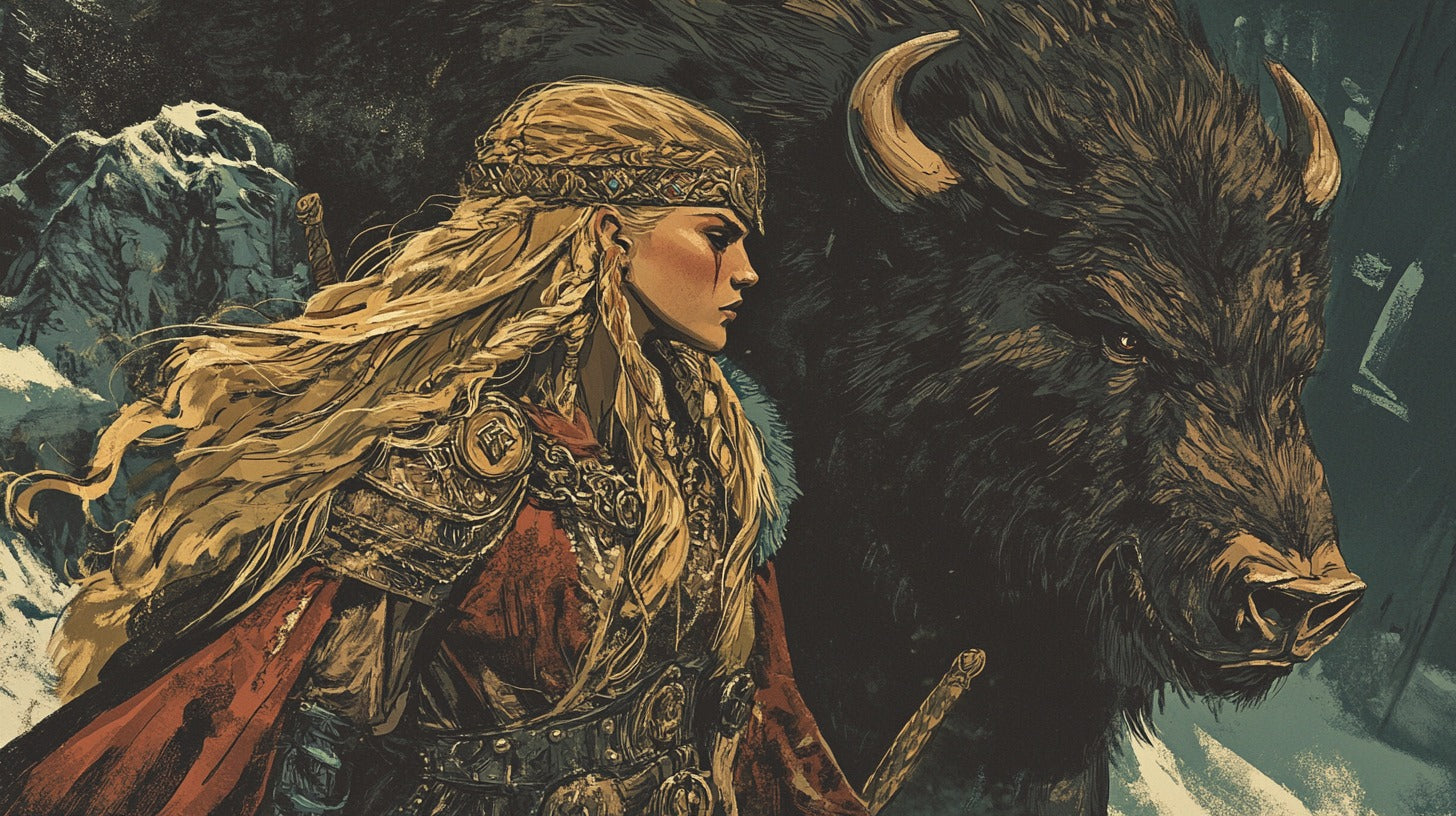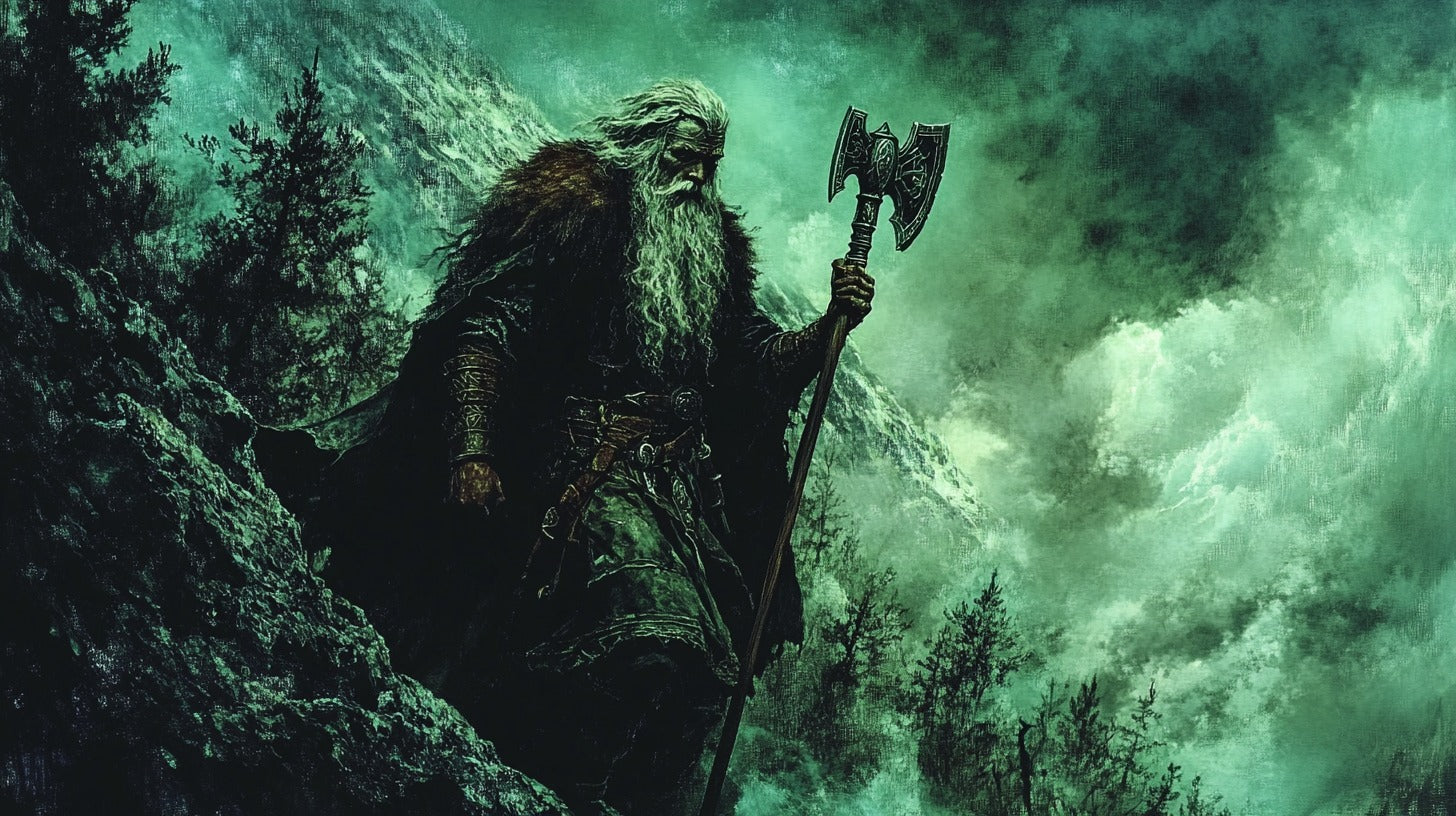
The Norse Creation Myth: A Journey Through Primordial Chaos
Fire and ice, creation and destruction, gods and giants – the Norse creation myth is a tapestry of opposing forces woven into a compelling narrative. It's a tale that begins in the yawning void of nothingness and culminates in a rich, vibrant cosmos teeming with gods, giants, and mortals. Let's peel back the layers of time and explore the birth of the Norse universe.
The Primordial Void: Ginnungagap
Imagine, if you will, a great emptiness stretching as far as the mind can comprehend. This is Ginnungagap, the "yawning void" that existed before all else. It's a concept both terrifying and awe-inspiring, a blank canvas upon which the entire Norse cosmos would be painted.

The Realms of Fire and Ice
But Ginnungagap was not destined to remain empty forever. To the north of this vast chasm arose Niflheim, a realm of primordial ice and mist. To the south, the fiery domain of Muspelheim came into being, a land of searing heat and flame. Can you picture it? Two opposing forces, ice and fire, with the great void caught between them.
As the heat from Muspelheim met the cold of Niflheim in Ginnungagap, something miraculous occurred. The melting ice gave rise to drops of eitr, a substance of pure creation. From these drops, the first beings emerged.
The Birth of Ymir and Audhumla
From the melting ice arose Ymir, the first frost giant and the progenitor of all giants to come. But Ymir was not alone in this newly formed existence.
The Cosmic Cow and the First Gods
Alongside Ymir appeared Audhumla, the primordial cow. Now, you might wonder, why a cow? In many mythologies, cattle represent nourishment and fertility, and Audhumla is no exception. She nourished Ymir with her milk, which flowed from her udders in four great rivers.

A painting by Nicolai Abildgaard (1790) depicting Ymir sucking the udder of Auðumbla whilst she licks Búri out of the thawing ice
But Audhumla had another crucial role to play. As she licked the salty ice blocks for sustenance, she gradually uncovered Búri, the first of the Aesir gods. Búri would go on to father Borr, who in turn fathered the brothers Odin, Vili, and Vé. These three would become the primary architects of the world as we know it.
Odin, Vili, and Vé: The Creation of the World
The stage was set for the next great act in this cosmic drama. Odin and his brothers, gazing upon the chaotic expanse of Ginnungagap, decided it was time to bring order to chaos.
The Slaying of Ymir
In a decision that would shape the course of Norse mythology, the three brothers chose to slay Ymir. It was a brutal act, but one deemed necessary for creation to continue. As Ymir's lifeblood poured forth, it created a great flood that drowned most of his giant offspring, save for Bergelmir and his wife, who escaped in a hollowed-out tree trunk.
Crafting the World from Ymir's Body
With the raw material of Ymir's massive corpse at their disposal, Odin, Vili, and Vé set about crafting the world. It's a gruesome image, isn't it? But in this act of creation from destruction, we see a theme that recurs throughout Norse mythology – the cycle of life, death, and rebirth.
Ymir's flesh became the earth, his blood the seas and lakes. His bones formed the mountains, his hair the trees, and his skull became the dome of the sky. The brothers took sparks and embers from Muspelheim and set them in the sky as stars, while Ymir's brains became the clouds.
The Nine Worlds of Norse Cosmology
As the brothers continued their work, the Norse cosmos took shape as nine distinct worlds, interconnected yet separate.

A diagram of the Nine Realms in Norse Cosmology / Illustration: Henry Wheaton (1831)
Asgard: Realm of the Aesir
At the top of this cosmic hierarchy sat Asgard, home of the Aesir gods. This celestial fortress, with its golden halls and rainbow bridge Bifröst, would serve as the setting for many of the most famous Norse myths.
Midgard: The World of Humans
Below Asgard lay Midgard, the realm of humans. Encircled by a great sea, Midgard was connected to Asgard by Bifröst, the rainbow bridge guarded by the ever-vigilant god Heimdall.
The Other Seven Realms
The Norse cosmos also encompassed Vanaheim (home of the Vanir gods), Alfheim (realm of the light elves), Svartalfheim (land of the dwarves), Jotunheim (world of the giants), Niflheim (the primordial world of ice), Muspelheim (the primordial world of fire), and Helheim (the underworld).
Yggdrasil: The World Tree
Binding these nine worlds together was Yggdrasil, the great World Tree. Its branches reached to the heavens, its trunk passed through the worlds, and its three great roots extended to three cosmic wells.

The Three Wells
At the base of Yggdrasil lay three wells: Urðarbrunnr (the Well of Fate), Hvergelmir (the Roaring Kettle), and Mímisbrunnr (Mímir's Well). Each of these wells played a crucial role in Norse mythology, from nourishing the World Tree to providing wisdom to the gods.
Creatures of Yggdrasil
Yggdrasil wasn't just a cosmic highway; it was a living ecosystem. The eagle Veðrfölnir perched atop its highest branches, while the serpent Níðhöggr gnawed at its roots. Between them, the squirrel Ratatoskr scurried up and down, carrying messages (and insults) between the two.
The Creation of Humans
With the cosmos established, there was one final act of creation left – the birth of humanity.

Ask and Embla: The First Man and Woman
Walking along a beach one day, Odin and his brothers came across two tree trunks. In an act of divine inspiration, they decided to breathe life into these wooden forms. Odin gave them breath and life, Vili bestowed consciousness and movement, and Vé granted them speech, hearing, and sight. Thus were born Ask and Embla, the first man and woman, from whom all humans are descended.
The Cycle of Creation and Destruction
But the story doesn't end with creation. In Norse mythology, creation is part of a greater cycle that includes destruction and rebirth.

Odin vs Fenrir and Freyr vs Surt / Painting: Emil Doepler
Ragnarök: The Twilight of the Gods
Looming in the future of this carefully crafted cosmos is Ragnarök, the "Twilight of the Gods." This apocalyptic event is prophesied to bring about the destruction of the nine worlds and the death of many gods, including Odin himself.
The World Reborn
Yet even in this bleak vision of the future, there is hope. After the fires of Ragnarök have burned out, a new world is foretold to rise from the ashes, verdant and full of life. Some gods will survive, and a new generation of humans will repopulate the earth.
Interpreting the Norse Creation Myth
Like all myths, the Norse creation story is rich with symbolism and meaning.
Symbolism and Meaning
The clash of fire and ice in Ginnungagap could represent the dualities present in nature and human experience. The creation of the world from Ymir's body speaks to the interconnectedness of all things. And the cycle of creation, destruction, and rebirth reflects the natural cycles observed in the world around us.
Comparisons with Other Mythologies
Interestingly, elements of the Norse creation myth find parallels in other cultures. The concept of creation from the body of a primordial being, for instance, is also found in Babylonian mythology. The World Tree is a common motif in many cultures, from ancient Mesoamerica to East Asia.
Legacy of the Norse Creation Myth
The influence of Norse mythology extends far beyond its original cultural context.

Influence on Literature and Popular Culture
From Wagner's operas to Marvel's Thor, from Tolkien's Middle-earth to Neil Gaiman's "American Gods," the echoes of Norse mythology resound through our modern cultural landscape. The raw power and primal imagery of the Norse creation myth continue to captivate creators and audiences alike.
Conclusion: The Enduring Power of Norse Mythology
As we conclude our journey through the Norse creation myth, we're left with a sense of awe at the sheer scope and drama of this cosmic narrative. From the yawning void of Ginnungagap to the intricate structure of the nine worlds, from the primal giants to the complex pantheon of gods, the Norse creation myth offers a vision of the universe that is both terrifying and inspiring.
In its tales of creation and destruction, of gods and monsters, of cosmic trees and rainbow bridges, Norse mythology speaks to something deep within the human psyche. It offers explanations for the inexplicable, order to the chaos, and meaning to the seemingly random events of life.
As we face our own challenges and uncertainties in the modern world, perhaps we can draw inspiration from these ancient tales. They remind us of the power of creativity, the importance of balance, and the eternal cycle of renewal that underpins all existence.
The Norse creation myth, like all great mythologies, is more than just a story. It's a window into the hopes, fears, and wisdom of our ancestors – a legacy that continues to enrich our lives and fire our imaginations to this day.
FAQs
- Who were the main creators in Norse mythology?
The main creators in Norse mythology were the brothers Odin, Vili, and Vé. They were responsible for slaying the primordial giant Ymir and using his body to create the world.
- What is Yggdrasil in Norse mythology?
Yggdrasil is the World Tree in Norse mythology. It connects the nine worlds of the Norse cosmos and plays a central role in many myths.
- How were humans created according to Norse mythology?
According to Norse myth, the first humans, Ask and Embla, were created by Odin and his brothers from two tree trunks they found on a beach.
- What is Ragnarök?
Ragnarök is the prophesied end of the world in Norse mythology, involving a great battle, the death of many gods, and the destruction of the nine worlds. However, it's followed by a rebirth of the world.
- How does the Norse creation myth compare to other creation myths?
The Norse creation myth shares some common elements with other mythologies, such as creation from the body of a primordial being and the concept of a World Tree. However, its specific details, like the creation from the interaction of fire and ice, are unique.
References
Sturluson, S. (13th century). Prose Edda. Iceland.
Anonymous. (13th century). Poetic Edda. Iceland.
Lindow, J. (2001). Norse Mythology: A Guide to the Gods, Heroes, Rituals, and Beliefs. Oxford University Press.
Gaiman, N. (2017). Norse Mythology. W. W. Norton & Company.
Crossley-Holland, K. (1980). The Norse Myths. Pantheon Books.







